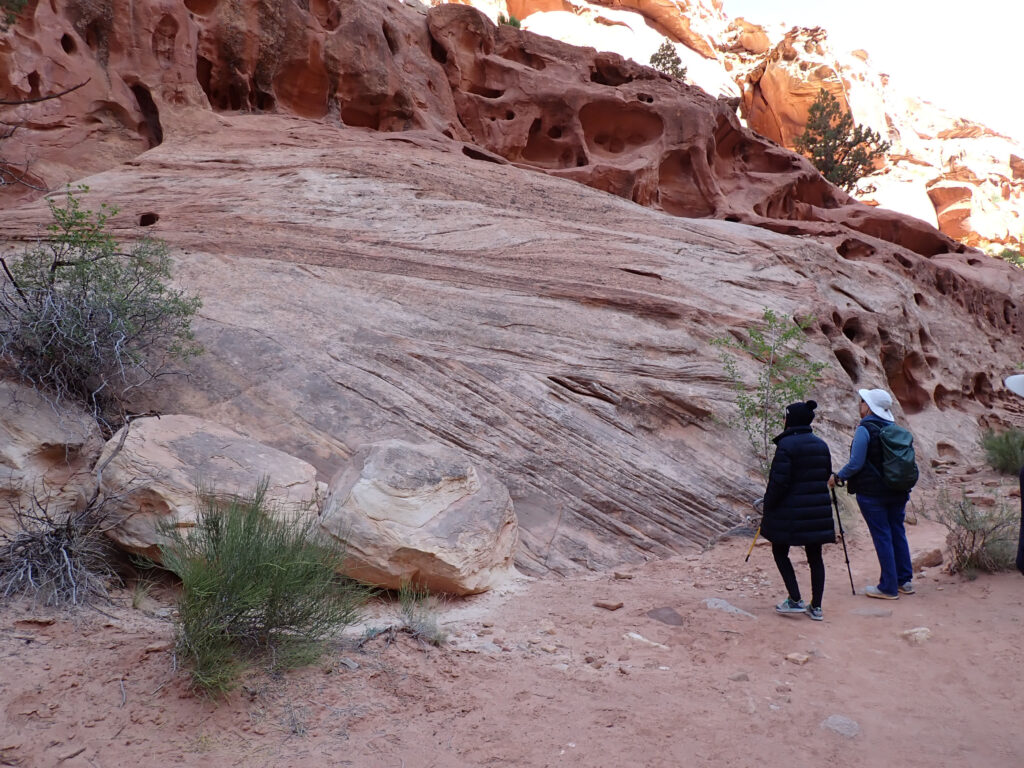
The name Capital Reef was given to this area by early settlers for a couple of reasons. The first settlers decided that the Navajo Sandstone outcrops resembled the dome of the Capitol building in Washington, DC. It is not clear which naming came first, but this one gets my vote; prospectors visiting the area (many with nautical backgrounds) referred to the Waterpocket Fold, an 87-mile-long ridge in the earth’s crust, as a reef, since it was a formidable barrier to transportation.
The Cliff Notes version of Capital Reef Geology supplements other blog posts. The park is still on the Colorado Plateau, so the geologic formations are comprised of many thousands of feet of sedimentary rocks deposited in a variety of environments. The readily visible formations include the Cutler Formation (White Rim Sandstone member) which is a 280-million-year-old (myo) coastal sand dune deposit; the Kaibab Limestone a 270 myo shallow sea deposit; the Moenkopi Formation a 245 myo mud and sandstone formation deposited in shallow seas and flood plains; the Chinle Formation (225 myo) which was deposited primarily in higher energy rivers and consists of petrified logs, sands, muds and windborne volcanic ash; and the Wingate sandstone, the Kayenta Formation and the Navajo Sandstone. The final three formations were deposited primarily under arid desert conditions demonstrated by extensive cross bedding (see pictures). The actual age of these final three formations is somewhat controversial allowing pompous white gentlemen geologists in their late 70’s and 80’s to sit around in big soft leather chairs smoking their pipes, sipping scotch to harumph and rail at the youngsters. In deference to both groups, let’s say the Wingate is 205 myo and the Kayenta and Navajo are younger with the Kayenta deposited between the Wingate and Navajo which was deposited from 190 to 180 mya. Due to the Waterpocket Fold/Monocline, a deep fault caused flexure in the earth’s surface, the older formations are visible on the west side of the park and the younger formations more visible on as you move east. Just to close this out, the uplift and erosion that has created the scenery and views is relatively young, having occurred in the last 45 – 20 million years.
Wow, that got a little out of hand. Sometimes a fit of geologic accuracy hits and you just have to go with it. Since one picture is worth at least 5,000 of my words, here is a NP generated section of the Waterpocket monocline.

We arrived at Capital Reef on the day that they closed the majority of the scenic road for the entire summer to facilitate repairs and rejuvenation. However, we were able to get to Grand Wash along the shortened scenic road which was our long hike trail selection. While the full trail goes from the scenic road through to state highway 24, we opted to do a 3.8 mile out and back portion from the trailhead parking area through the Narrows area. The Wash is an up to 850-foot-deep canyon resplendent with geology and rocks everywhere. We had decided that the canyon walls were about 150 to 200 Joni’s high based on a visual estimate. The hike began with chilly and blustery weather. However, once in the canyon, the winds were blocked, and the sun warmed it up nicely. One of the social highlights of the hike was an encounter with a University of Alaska geology field trip class. Nice bunch of kids who seemed to be pretty focused on their task.
We also hit the Gifford House and bought a couple of pies, the petroglyph site along Utah Highway 24, Panorama Point and the Goosenecks before returning to a Mexican restaurant for the requisite post hike beer and feast.
That wraps up the May Southern Utah trip. We had a great time with Joy, Larry, Cheyenne and Louie and thoroughly enjoyed their hospitality and the opulent RV accommodations. As I have aged, I appreciate the whole concept of more or less regular showers, no-fuss hot coffee in the morning, cold beer in the evening and flush toilets even while “roughing it”.
